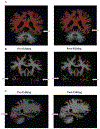Cortical Thickness, Volume, and Surface Area in the Motoric Cognitive Risk Syndrome
- PMID: 33867359
- PMCID: PMC8768501
- DOI: 10.3233/JAD-201576
Cortical Thickness, Volume, and Surface Area in the Motoric Cognitive Risk Syndrome
Abstract
Background: The motoric cognitive risk (MCR) syndrome is a pre-clinical stage of dementia characterized by slow gait and cognitive complaint. Yet, the brain substrates of MCR are not well established.
Objective: To examine cortical thickness, volume, and surface area associated with MCR in the MCR-Neuroimaging Consortium, which harmonizes image processing/analysis of multiple cohorts.
Methods: Two-hundred MRIs (M age 72.62 years; 47.74%female; 33.17%MCR) from four different cohorts (50 each) were first processed with FreeSurfer 6.0, and then analyzed using multivariate and univariate general linear models with 1,000 bootstrapped samples (n-1; with resampling). All models adjusted for age, sex, education, white matter lesions, total intracranial volume, and study site.
Results: Overall, cortical thickness was lower in individuals with MCR than in those without MCR. There was a trend in the same direction for cortical volume (p = 0.051). Regional cortical thickness was also lower among individuals with MCR than individuals without MCR in prefrontal, insular, temporal, and parietal regions.
Conclusion: Cortical atrophy in MCR is pervasive, and include regions previously associated with human locomotion, but also social, cognitive, affective, and motor functions. Cortical atrophy in MCR is easier to detect in cortical thickness than volume and surface area because thickness is more affected by healthy and pathological aging.
Keywords: Cognitive complaint; cortical thickness; gait; motoric cognitive risk.
Figures


References
-
- Ayers E, Verghese J (2016) Motoric cognitive risk syndrome and risk of mortality in older adults. Alzheimers Dement 12, 556–564. - PubMed
Publication types
MeSH terms
Grants and funding
LinkOut - more resources
Full Text Sources
Other Literature Sources
Medical

